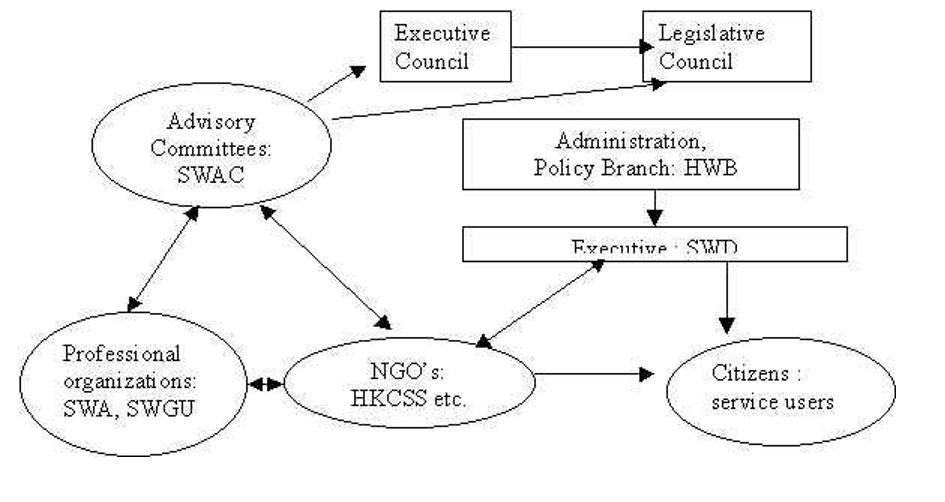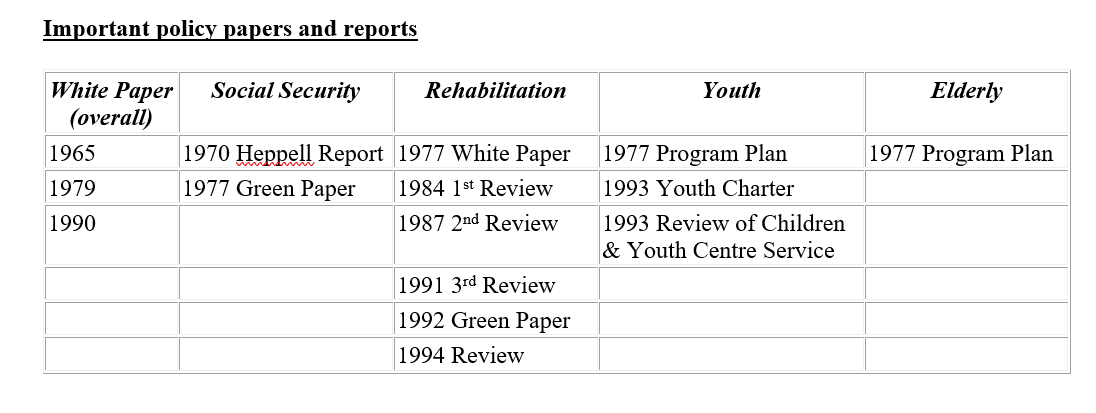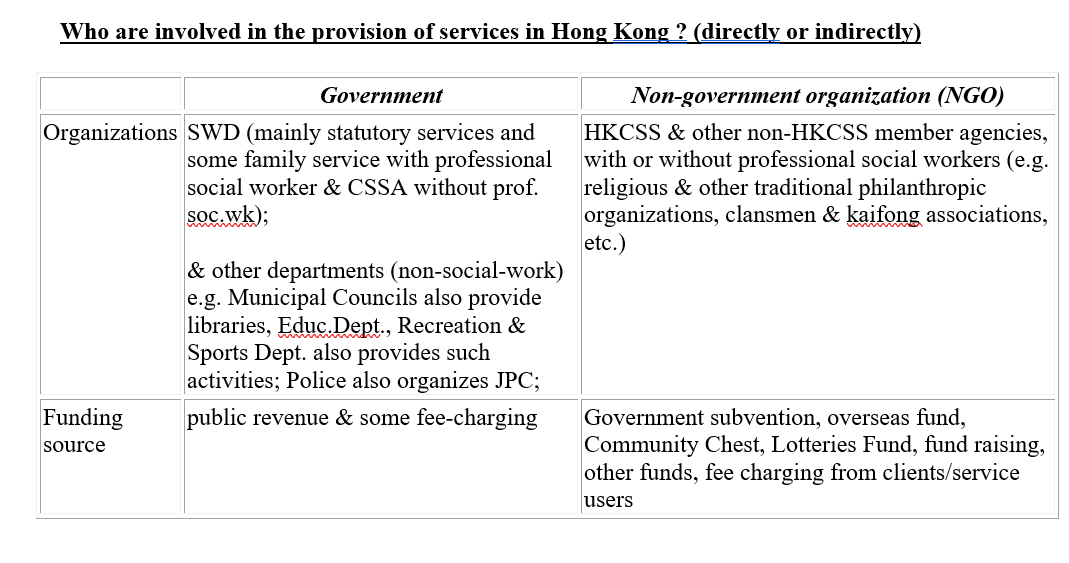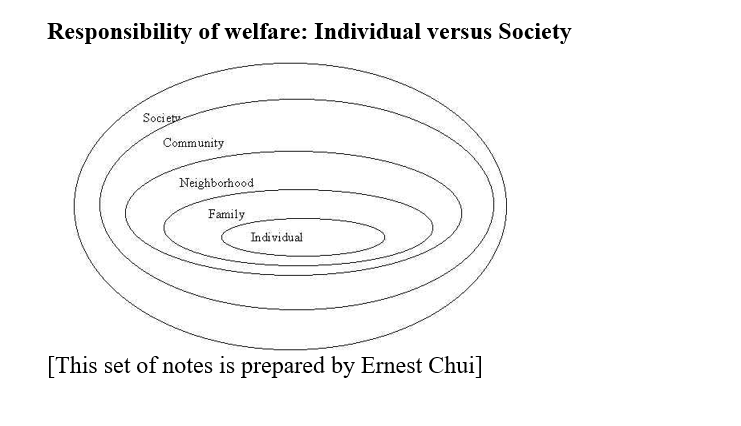ECONOMIC domain:
- mode of production – relation of production (mode of ownership of means of production)
e.g. agrarian society vs industrial society will have different modes of welfare (see above)
- economic structure:
- proportions of the various components of agriculture, industries (light vs heavy), commerce, service, finance…etc.;
- ratio of public (government) and private sector in entire economy; or government’s control of economy;
- level of productivity in society:
- labour productivity – quantity (population size, structure) and quality (education and skill level, orientation to work) – wealth of nation (Gross National Product GNP);
- a higher productivity can produce greater GDP/GNP to finance welfare,
- government financial policy & situation:
- source of revenue – tax base, tax structure & policy;
- fiscal policy, balance of payment; and monetary policy—control over the economy
- higher tax can finance more welfare;
- citizens’ mode of consumption:
- culture, value system, family functioning….etc.
- greater personal saving will reduce government’s welfare burden;
POLITICAL domain:
- structure of society:
- social cleavages – conflicts (e.g. race, religion, economic situation, sex…..etc.);
- configuration/structure of political power;
- more pluralistic society encourages more welfare for different sectors of people;
- legitimacy / origin of political authority (government formation):
- pluralistic competition or autocracy ?
- a government without citizens’ legitimization may provide more welfare to appease citizens;
- structure of the polity:
- mutual check-and-balance among the 3 branches of authority – legislature, executive, and judiciary ?
- a more powerful legislature may force the executive branch to provide more welfare (to appease the electors);
- political culture:
- civil society developed or authoritarianism ? are the people participatory or apathetic ?
- a more participatory citizenry may force government to provide more welfare;
- salience and coverage of government intervention:
- extent of government influence/penetration into citizen’s living;
SOCIAL domain:
- population:
- quantity & structure (“dependency ratio”, productivity);
- quality (education, skill, technology, work ethic…etc);
- a more productive population may produce higher GDP to finance more welfare;
- social structure (of the civil society):
- family structure and functions;
- civic organizations (e.g. kaifong associations, kinship or locality associations, trade unions/ professional associations, pressure groups, religious organizations ….etc.) – numbers, activity and function in society;
- stratification – along wealth, race, religion, sex, prestige….etc. (the 3 “P”s : property, prestige, power);
- culture:
- value system, norms, moral standards, traditions; religions; political culture, civic awareness….etc.;
- a ‘self-reliant’ culture may reduce demand for government welfare;
CONCEPTUAL FRAMEWORK for studying social welfare
1. Identify the need/ problem:
- what kind of problem is faced by the people concerned (e.g. the elderly, the children, the disabled, the women….etc.);
- what kind of need is derived from such kind of problem(s): e.g. the problem of inadequate jobs calls for the need for job placement, the problem of inadequate nutrition calls for the need for improvement in diet; etc.
- assess the degree or extent of such kind of problem and need e.g. number of people affected, proportion in society, duration of such kind of problem….etc.;
2. Analyze the various possible factors leading to such problem and need :
- is it caused by individual or social factors ? e.g. individual inadequacy in character (e.g. being lazy ?) or societal structural problems ? (e.g. racial or sexual discrimination, deprivation …?)
- is it caused by single or multiple factors ?
- assess and weight the relative incidence of different possible factors attributing to the problem/ need;
3 Identify the agents who/ which are responsible directly/indirectly to cause the problem:
- are the individuals who are suffering responsible for their own problems ?
- is the government responsible ? are the employers responsible ?
- are the other social systems like the family, the religious institutions, interest groups….etc. responsible ?
4. What can be done to remedy the problem or satisfy the need ?
- what measures can be taken to improve the situation ? e.g. increasing welfare ? improve functioning of some social systems like the family, the neighbourhood, the kinship system, the religious institutions, the educational system, the political system …. etc. ?
5. Critical examination of underlying values, assumptions, beliefs, cultural norms/ traditional mores….etc. throughout the exercise:
- is the definition/ identification of problem/ need affected by some specific set of beliefs/ values ?
- is the identification of responsible agents biased by some particular assumptions (e.g. the government should bear ultimate responsibility to provide welfare);
- is the decision on choice of solutions affected by some non-rational, not well-thought considerations ? (e.g. increase welfare provision by government will incur higher taxes, will the economy be affected ?);
Hong Kong’s social welfare POLICY FORMULATION and ADMINISTRATION
Organizations (‘actors’) involved in policy initiation and formulation:
- Executive Council [EC] lays down general policy direction esp. long-term
- Legislative Council [LC] (if there’s a need for legislation) (now our Dept has DrCKLaw & Dr.YeungSum as LC Councilors)
- Welfare Panel of Legislative Council立法會福利小組 (for policy discussions & monitoring the gov’t)
- Social Welfare Advisory Committee (SWAC) 社會福利咨詢委員會 (advising on government’s policy) (** now we have Dr CKLaw & Dr Joe Leung serving as members)
- Health & Welfare Bureau衛生福利局 (policy and/or legislation initiation)
- Social Welfare Department (SWD) 社會福利署 (implement policies laid down by Bureau & LC)
- Advisory Committee on Social Work Training and Manpower Planning (ACSWTMP) 社會工作教育及訓練咨詢委員會 (including all department heads of universities providing social work training)
- Hong Kong Council of Social Service (HKCSS) 香港社會服務聯會–社聯 (gov’t recognized representative role in coordinating different NGOs in giving policy feedback to government) (** our Dept has a number of staff actively involved in the HKCSS’s work)
- Hong Kong Social Workers Association (SWA, 香港社會工作人員協會–社協) policy critique
- Hong Kong Social Workers General Union (SWGU, 香港社會工作人員總工會–社總) policy critique
[1-6 formal channels; 7-9 informal channels]
(at local level, the District Council [previously called District Board ‘DB’] will also be consulted on the implementation of welfare services)

Different levels of policy paper/plans:
- White paper:policy paper for laying down the major basic principles of the government in provision of welfare, usually published after the consultative green paper, 4 White Papers: 1965, 1973, 1979, 1991 “Social Welfare into the 1990’s”.
- 5-year Plan: 5-year rolling plan of various social welfare programs, review biannually by both SWD and voluntary sector (HKCSS).
- Program Plan: detailed plan of a particular social welfare service, e.g. personal service for youth, elderly, rehabilitation, social security….etc.
The 3 types of plans provide different levels of analysis and planning for social welfare service provision;
[ ???? Issue for discussion: Is there enough public participation or professional input in drafting and planning of various plans ????? ]

Social welfare planning approaches in Hong Kong
- by target groups: handicapped, old people, youth, family, women, …..
- by population: neighbourhoods, areas, districts, region, …..
- by social problems: drug addiction, prostitution, housing, violent crime, alcoholism
- by division of labour:: medical service, financial service, housing, transportation, education, welfare service
Financing of Social Welfare in Hong Kong
4 major sources of funding for social welfare: (1) government (subvention), (2) donations (from overseas or local), (3) program /membership fees; (4) independent funds (e.g. Lotteries, Keswick Foundation, etc.)
The government adopts different subvention practices at different periods of time:
- Standard Cost subvention: i.e. a standard rate of subsidy is calculated according to the operating expenses (e.g. salaries for social workers, program fees) e.g. OR, FLE, NLCDP, School SW, Family Counseling, C&Y Centre)
- Model System: provided on the basis of recognized costs of the unit
- Discretionary grant: most NGOs; Deficiency grant: e.g. SARDA, hospitals, schools
- E.N.D. Formula – Essential, Necessary, Desirable 3 types of services with decreasing priorities of subsidy; Category I (100% subsidy) & Category II (70%)
- 1995 SWD started to consider revising subvention policy, proposed “unit grant”, “funding & service agreement”; 1998-2000 Lump Sum Grant
A trend for NGOs to change from depending mainly on overseas funding (mainly in 1950-60s) —-> to rely heavily on government. subvention —-> will eventually change to fee charging in future [issue for discussion:: why doesn’t the govt. run the service by herself when services are totally funded by the govt?

Partnership of the government and non-governmental organizations (NGOs):
(1) NGOs contributions: usually start upon private initiatives, small, innovative, pilot projects, volunteer participation, responsive to new needs, cheaper to run, watchdog role,
- some famous service agencies are: Po Leung Kuk (保良局), Tung Wah Group of Hospitals (東華三院), Hong Kong Caritas (明愛), HK Federation of Youth Groups (青年協會), Boys and Girls’ Clubs Association (小童群益會), HK Family Welfare Society (香港家庭福利會)…
- (you can obtain a list of HKCSS members from the Council’s annual report)
(2) Government contributions: manifestation of goals of equality and fraternity, legislation, control, set and uphold standard, subvention control, statutory services, monitoring of public funds, institutionalize policy and service planning, welfare state provision from `Cradle to Grave’.
(3) Individuals and family contributions: informal support, source of gratification, personal care, emotional dependency,
(4) Community contributions: informal assistance and support from neighbors, volunteers, etc. donations (e.g. Community Chest, Tung Wah & PoLeungKuk fund-raising, etc.)

Here are the top 5 characteristics that I would consider very necessary.
1. It Should Be Simple
A social media policy is something that should be easily understood by everyone in your company. It can be very short or slightly more wordy, including a lot more detailed information and guidance. In any case, it should contain a summary, providing easy steps that all employees can follow in their day-to-day social activities. Concepts should de defined if necessary, but you need something clear and concise to start with.
2. It Should Align With Company Culture
If you have spent a lot of time and effort on creating an awesome company culture, the last thing you need is a policy that could kill it.
If your company is more conservative, your social media policy could be stricter, but not overstep your company culture. However, it should always consider and address issues that the company feels strongly about, making clear what is acceptable and what is not. You should draw clear lines that should not be crossed. If your company culture is suffering, the last thing employees are going to adhere to is a social media policy.
3. It Should Empower Employees
Allow your employees to speak out. You should always respect your employees’ rights to free speech, or their ability to discuss issues that are important to them. Local cultural characteristics exist if your company has offices in various countries, but you need to have a consistent approach across the company. A social media policy is a guidance tool, and should manage, rather than limit. A simple, clear and fair policy ensures that people don’t feel violated in any way.
4. It Should Seek To Help
Make your social media policy useful. Train your employees and teach them things that will get them ahead in the game. The more they know, the better they use the tools that you are encouraging them to. Get them excited about your initiatives, not because they you’re forcing them to, but because they will actually help them.
5. It Should Be Legal
If you are expecting to get away with limiting your employees legal rights, forget it. The last thing you need is to be entangled in legal proceedings because of something you could have easily avoided by being more reasonable. Local laws should also be respected. I would think this is obvious to all.
That’s it with my list of top 5 characteristics of a great social media policy for your company. Can you think of any to add?
